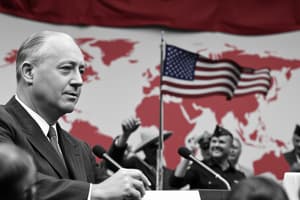Podcast
Questions and Answers
What was the primary focus of Franklin Roosevelt's foreign policy?
What was the primary focus of Franklin Roosevelt's foreign policy?
- Maintaining America's isolation from global conflicts
- Promoting trade without diplomatic relations
- Integrating the United States into global military alliances
- Transitioning from isolation to international intervention (correct)
What limitation did the Neutrality Acts impose on Roosevelt's foreign policy?
What limitation did the Neutrality Acts impose on Roosevelt's foreign policy?
- Establishment of a complete arms embargo and travel restrictions (correct)
- Requirement of U.S. military service for all citizens
- Prohibition of all forms of trade with foreign nations
- Mandating that America lend support only to allies
Which policy allowed the United States to supply goods to belligerents during the war?
Which policy allowed the United States to supply goods to belligerents during the war?
- 'Cash-and-carry' principle (correct)
- Lend-Lease Act
- Destroyers-for-bases arrangement
- Good Neighbor Policy
Which agreement involved the exchange of naval vessels for the right to build bases?
Which agreement involved the exchange of naval vessels for the right to build bases?
What event led to the United States' official entry into World War II?
What event led to the United States' official entry into World War II?
Flashcards are hidden until you start studying
Study Notes
President Franklin Roosevelt's Foreign Policy
- Shifted U.S. foreign policy from isolationism to interventionism.
- Initiated cautious engagement through diplomatic relations and trade with the Soviet Union and Latin America under the Good Neighbor Policy.
Neutrality Acts
- Enacted Neutrality Acts in 1935, 1936, and 1937 restricted U.S. involvement in international conflicts.
- Established arms embargo, loans, and trade restrictions with nations at war.
- Enabled 'cash-and-carry' provision, allowing goods to be sold to belligerents if paid for in cash and transported on non-American ships.
War Preparation and Support
- As global crises escalated, Roosevelt recognized the need for increased U.S. intervention.
- Lifted the ban on arms under the Neutrality Acts to supply Britain and France with weapons.
- Authorized the 'destroyers-for-bases' deal, trading naval vessels for American military bases on British territory.
Lend-Lease Act
- Successfully navigated the Lend-Lease Act through Congress to provide arms to allies, reinforcing support for nations fighting against Axis powers.
Atlantic Charter
- Collaborated with Britain to establish the Atlantic Charter, outlining shared war aims and principles for post-war peace.
Economic Measures Against Japan
- Implemented financial actions against Japan, including freezing Japanese assets in the U.S. and limiting trade, heightening tensions before conflict.
Entry into World War II
- Following the attack on Pearl Harbor on December 7, 1941, Roosevelt declared war, completing the transition from isolation to active military intervention.
Studying That Suits You
Use AI to generate personalized quizzes and flashcards to suit your learning preferences.



